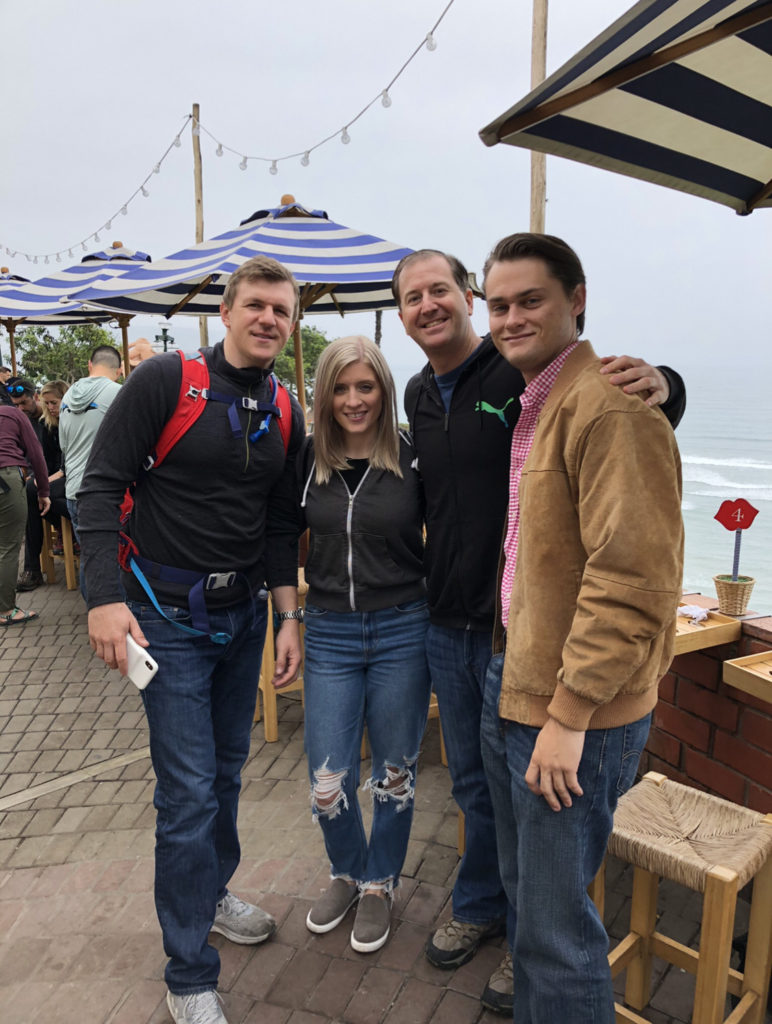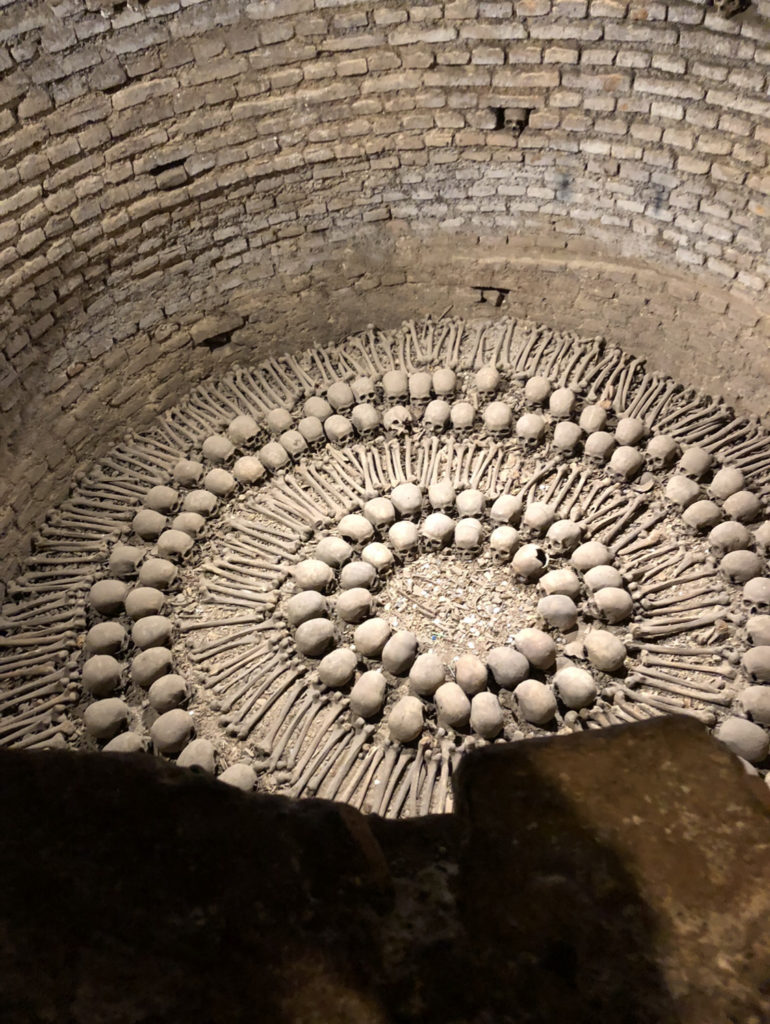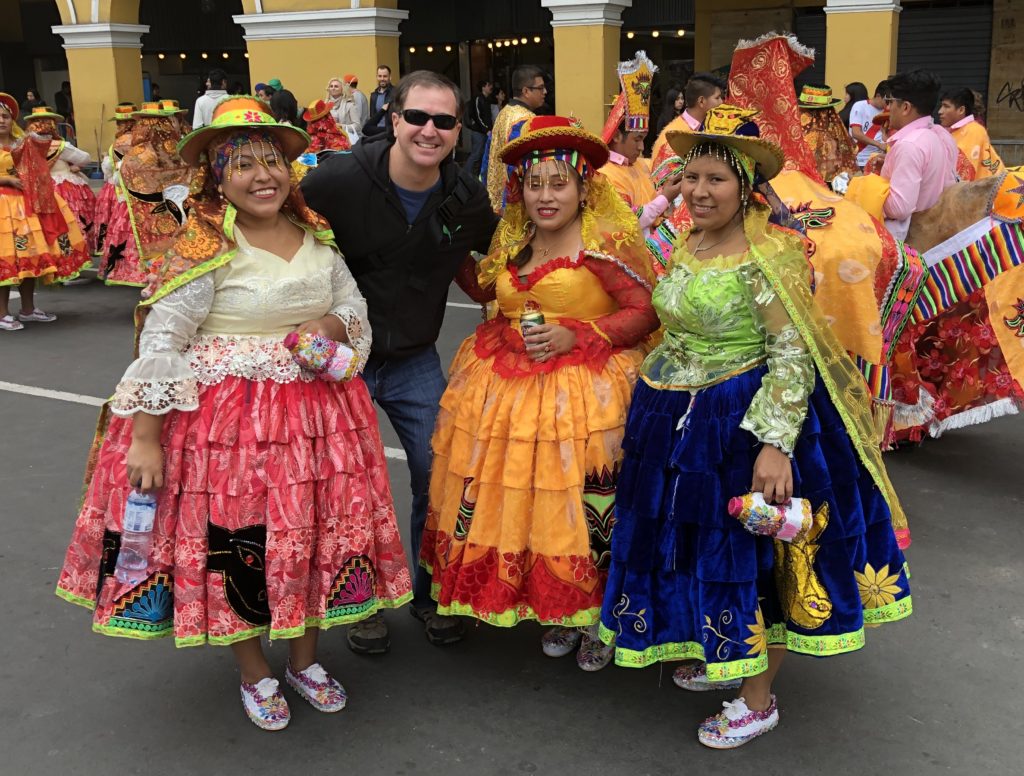I’m excited about being in Peru. Before coming here, I read a book, which I am finished during the journey. It is titled Turn Right at Machu Picchu by Mark Adams, a modern day travel writer and historian who followed the Inca Trail and retold the story of Hiram Bingham’s discovery as he walked in Bingham’s footsteps.
In his book (published in 2012), Adams describes Peru’s uniqueness on the globe, as he writes: “Peru’s borders contain some of the world’s most varied topography and climate. Measured in square miles, the country is not especially large. On a globe it looks like a swollen California. Within that space, though, are twenty-thousand-foot peaks, the world’s deepest canyon (twice as deep as the Grand Canyon), unmapped Amazon jungle and the driest desert on earth. Peru is an equatorial country that depends on glaciers for drinking water. It’s one of the world’s hot spots for seismic and volcanic activity. (Both Lima and Cusco have been leveled by earthquakes; the country’s second-largest city, Arequipa, sits beneath a smoking peak that could blow its top at any time.) Scientists have calculated that there are thirty-four types of climatic zones on the face of the earth. Peru has twenty of them.”

While that geography and topography is stunning, on Saturday, June 29 we ventured out into the most populated city in Peru, the capital city of Lima. The apartment we were staying in the Miraflores area of the city, was just two blocks from the Pacific Ocean, which we could see from our fourth-floor window. More exciting for me as a life-long tennis player is the view of the red clay tennis courts just across the street. It’s too bad I didn’t have time to play any tennis here as our short time in Lima was packed with lots to see. While I’m sure a tennis racket could have been rented, I also only brought one pair of shoes: my hiking shoes.
We awoke and were out the door by 9am on Saturday. We went over to a French café with crepes called Beso Frances Creperia. It was right on the water, overlooking the Pacific Ocean surrounded by a lot of public art in the six-mile stretch of parks in Miraflores. We saw lots of people out and about, doing all sorts of activities – especially a lot of runners and bikers. Our food order was placed at a counter and it took a little longer than we expected. We had stopped here because we hoped for something fast. The coffee, juice, crepes, and sandwiches were all delicious – and the view was hard to beat! We then took an Uber from there to the Plaza de Armas area, about a 35-minute ride. Our plans were to visit multiple sites within just a few blocks of each other.

We started with the Basilica and Convento de San Francisco. It’s a beautiful old church, but the most unique feature of it is the catacombs beneath the church. This was accessible from the museum area of the building, which is to the left side of the main entrance of the church. We had a guided one-hour tour which was really worth the time and minor entry fee. The guide walked us through everything including the catacombs. They said most people who were buried here were of the wealthier classes as they had to pay to be buried here. They believe more than 25,000 bodies were buried here – and many of the bones were organized in unique ways. Just piles and piles of bones. And many, many skulls. Above us, a mass was taking place in the church and in some parts of the catacombs we could look up and see through the cracks in the floors and see the participants in the mass. The day we visited, Saturday, June 29, was a national holiday in Peru: to celebrate the feast day of Saints Peter and Paul. There was much color and festiveness both in the churches and on the streets.
We then walked over to the Plaza de Armas so that we could see the changing of the guard at the national palace (aka the Government House) which takes place at noon each day. We sat there and watched a very ceremonial event go on for just over 30 minutes. It was like something you might see at Buckingham Palace in England. There was a band, there were multiple groups of soldiers with rifles, it was quite something.

While there, we noticed there were lot of police in riot gear in the Plaza de Armas, including next to the national palace. The streets leading into the plaza were blocked to all automobile traffic. This was nice so that we could walk around freely without having to worry about vehicles. And we weren’t quite sure if it was like this every day. But we found out not much later that today was a big day for Peruvian soccer. The men’s national team was playing Uruguay in the Copa America 2019 tournament and there was also a giant video screen set up on one side of the plaza, where hundreds of soccer fans congregated to watch. Peru ended up winning that game and in fact won every game they played while we were still in the country. They would wind up losing to Brazil 1-0 in the final, which took place the day after we left Peru.
As we walked through the Plaza de Armas, we went south about two blocks to a highly recommended restaurant on TripAdvisor called Embarcedero 41. Marshall and I both tried the Lomo Saltado which was really excellent. The food in this country is quite flavorful.

After lunch we made our way back to the Plaza de Armas. I was hoping to check out the Cathedral of Lima, but was told it was not open for viewing today. However, there was a massive parade going on in the streets of downtown Lima which culminated in front of the Cathedral, where hundreds of people were congregated and the parade was quite festive with many colorful costumes. This parade was to celebrate the holiday of the Feast Day of Saints Peter and Paul.
Peru is a very Catholic country and that is mostly thanks to the Spanish influence that has persisted since Francisco Pizarro wiped out the last Inca emperors in the middle part of the sixteenth century. There used to be a statue of Pizarro on a horse in front of the National Palace in the Plaza de Armas, but it was removed in 2005. Pizarro may have been the conquistador that conquered the Incas, but his brutality in doing so doesn’t hold up in the twenty-first century. Regardless, I had learned that his statue was moved a few blocks away to La Muralla Park and we went to check it out. I’m glad we did. It was massive. And while you can’t miss it if you walk by it, you almost have to be looking for it, because it’s sort of in a nondescript area of that park, hidden from view by a pedestrian bridge that is next to it.

Before leaving the Plaza de Armas area, we wanted to visit Casa de Aliaga, the oldest dwelling in the Americas that has been owned by the same family for 17 continuous generations. One of the rooms has a sword and a portrait of the first patriarch of the Aliaga family that owned this home, Captain Jeronimo de Aliaga y Ramirez, who built this home over the remnants of an Inca temple in Lima. After the founding of Lima on January 18th, 1535, Captain Jerónimo de Aliaga y Ramírez received a colonial house in the elegant area near the house of Francisco Pizarro, the Spanish Conqueror, (today the Government Palace). The sword in that room was used to kill one of the last Inca emperors. And it was apparently the sword of Captain Jerónimo. The chapel in the home is the oldest existing chapel in the Americas (we were told, though friends from the Dominican Republic tell me there are older chapels and churches there). Perhaps this is the oldest private chapel in the Americas – that makes more sense. And yes, there is a beautiful statue of Christopher Columbus inside the foyer area of the home. Everything in this home was elegant and so much is original to the home.
This home was not easy to find. I wish I had taken a picture of the big, yet old, wooden door we had to knock on to be asked to tour. There are two rooms that were closed and locked in the foyer area, and that is where Mr. Gonzalo Aliaga lives. He lives here alone, as he is divorced from his wife and his three young adult children live in other, wealthier areas of Lima. The oldest son will inherit the home when his father passes, as I believe is appropriate. This is a rare find in the center of Lima and we saw only a few other people touring it while we were there. We had our own guide, a native Peruvian. When he learned where we were from, he said immediately: “The United States is such a wonderful country.” Indeed, it is. But I immediately replied back to him: “So is Peru!”

Some other fun things to do while walking these streets of Lima is to eat some churros and also walk away from the plaza and people watch, including seeing some street performers. We walked south towards the Grand National Bolivar Hotel and peered inside the lobby. Many famous people stayed here including U.S. President Richard Nixon, Bobby Kennedy, Clark Gables, Ernest Hemingway, and the Rolling Stones. We also saw a Ford Model T sitting inside the lobby.
Seeing all of these sites took a little longer than I had expected (plus we got a later start to the day from that slowly served breakfast). So, it was nearing 4pm and that’s when we decided to Uber back to our hotel in Miraflores. We took some rest here (except Jessica, she continued walking around the Miraflores area).

We then headed out for 7pm Saturday vigil mass at Iglesia Virgen Milagrosa, a Catholic church which had some really unique lighting. It was situated next to JFK Park, where some kind of art and crafts festival was going on.
From there, we had hoped to maybe get lucky and find a table at the Maido restaurant, which is rated one of the top 50 restaurants in the world. This is a place that you typically need to reserve about a month in advance, I’m told. They told us to come back in an hour and we might get lucky for some walk-up seating. We were hungry so this was a hard pass. We found a really nice restaurant just across the street named Rigoletta Lima. It was quiet, yet about half-filled and it had excellent reviews on TripAdvisor. And for good reason. The food and service there was excellent.

We filled our bellies and then we headed to the Barranco area of Lima, about a 10-minute Uber ride away. This is a now a happening night spot for some hip bars and restaurants. We visited the famous Bridge of Sighs and then sat down for a cocktail at a very cool spot called Ayahuasca (which is named for the Peruvian spiritual medicine that can also be used by some as a hallucinogen). They had great music, lots of indoor and outdoor seating and just a really cool vibe — all inside a colonial plantation home. We were tired though, so we weren’t there long. After hanging there for about an hour, we then took a 15-minute Uber ride back to our apartment to call it a night. This was truly a great full day in Lima. As Jessica said: we did everything on the itinerary. And then some.
